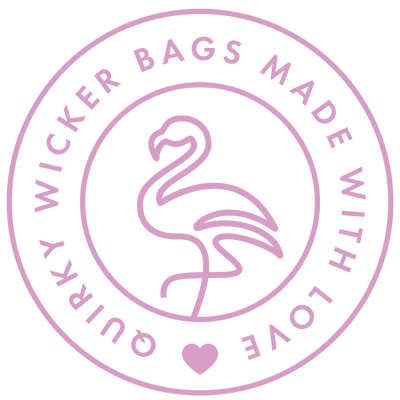What is a Rattan Handbag? Hand Woven in the Philippines
So my buttery biscuits, you've ogled over a woven vintage chair or two. Maybe your monstera is lucky to call a rattan planter his humble abode. But what do you know about the lovely plant that makes the wicker rattan handbags, keychains, and other items we love so much?
Let’s take a look at the origins of our favourite flamingos and the rest of their perfectly-proportioned posse - and the glorious glow-up process of our wicker handbags.
Because it is a LOVELY plant. I mean, it's no accident we chose rattan to weave our designer handmade handbags and tiny keychains with.
What is rattan?
Rattan is a naturally growing and swiftly renewing vine-like palm that grows in Asia, Australia and Africa. It is commonly used for weaving and the construction of wicker furniture.
This climbing vine is strong, fibrous, lightweight, durable, flexible and easy on the eye if I do say so myself. It makes gorgeous baskets, planters, chairs and, of course, rattan handbags!
Although this plant may look similar to bamboo, don’t be fooled! While they can be used for similar purposes, this is a different category of plant altogether - a category made up of over 600 species of plants.
Unlike bamboo, rattan doesn’t like getting rain on its meticulously coiffed curves. For that reason, this particular material is recommended for indoor use only - although of course you can protect your rattan handbag with an umbrella.
While we’re on the subject...if you adore rattan handbags as much as I do, it’s important to know how to care for your wicker handbag. Getting them wet can cause them to lose their shape, and develop mould and mildew!
We all have our kryptonite, so we can’t hold a little aquaphobia against our cute handbags. There are SO many reasons that this material is simply fabulous to work with.
-
Rattan is easier to harvest than wood.
-
It is one of the fastest growing natural materials.
-
It is extremely low maintenance and requires only a bit of dusting every now and then.
- And it easily takes to paint and varnish the way wood does, which is why we’re able to create such lovely hand-painted purses at Wicker Darling.
As an easy, eco-friendly and beautiful material, you can see why we have chosen this extra-special vine for our handmade handbags.
Rattan handbags and wicker handbags might look that same to you - and that’s because many wicker bags are actually made from rattan. Contrary to popular belief, wicker is not a material, but a style of weaving. Wicker can be made from reeds, bamboo or rattan.
Now you might be thinking to yourself - ‘Well it’s lovely that wicker is made from natural materials, but is wicker & rattan sustainable?’
Well I am just so glad you asked!
Is rattan sustainable?
Slow fashion lovers rejoice. Rattan is sustainable!
This versatile vine is an incredibly quick-growing plant that rapidly renews. A single vine can grow up to 200 meters in one year, which is seven times faster than the growth of a tree.
Rattan can actually protect trees too. That’s because the vines need trees to grow on, so if someone is growing and harvesting them, then all the trees in that area are protected indirectly from deforestation. In addition, rattan requires very little water and absolutely no pesticides to grow, so it is easy on both the workers and the environment.
One of the best things about the set-up at Wicker Darling is that our rattan is grown, harvested, prepped, woven into rattan handbags and painted all locally in the Philippines.
That means we don’t need to transport materials or ship long distances to create our rattan handbags, and it helps to cut back on our carbon footprint while supporting the local community.
And, while this material is durable and long-lasting, it is also biodegradable, so you will never have to worry about your rattan handbag taking up space in a landfill (although I sincerely hope your wicker life partner doesn’t end up there in the first place!)
Something else that makes Wicker Darling, in particular, sustainable is that our rattan handbags are made to order - or, rather pre-order - only. This means we will never use more resources than we have to, and every bag will have a loving home ready and waiting for it.
So we know where this rattan is GOING, but where does it come from?
Where does rattan come from?
Rattan vines naturally grow in hot, tropical regions, which is why many people associate wicker with a beachy, bohemian vibe.
Around 80% of the world’s supply of rattan comes from Indonesia.
The remaining 20% is split up between the Philippines (where we get ours!), Malaysia, Sri Lanka, China, Bangladesh, Laos, Cambodia, Vietnam, South Africa, and several other countries, including the northernmost tip of Queensland in our very own Australia.
Each country has its own unique styles and techniques when it comes to using this amazing vine for furniture or wicker weaving.
How is rattan used to make things?
You know that a designer rattan handbag doesn’t just happen.
Here’s how it works: When rattan is first harvested, it is cut into more manageable pieces around 4 meters long.
Then, it needs to be dried completely before it can be worked with. The spiky outer portion will be removed, and the inner poles will be straightened, graded for size and quality, and used as a framework for furniture or cut into strips for wicker weaving.
Cutting the vines into even and finely smoothed strips for weaving takes incredible care and skill. Then, the vines might be smoked in sulphur to give them a deeper colour, or given an oil bath to help condition the fibers to maintain their shape.
The hand weaving process is meticulous and time-consuming. It could take an entire month for a skilled rattan weaver to make just a single bag! The hand-weaving makes rattan handbags with impeccable quality.
And it’s not easy either. Wicker weaving is a skill that has been passed down from generation to generation dating all the way back to Ancient Egypt. (Check out the wicker furniture from King Tut’s tomb dating back to 3,000 B.C.!) It takes a lot of knowledge and craftsmanship.
Some wicker weaving is done in 2D, weaving a sheet of rattan or bamboo that is then wrapped around the frame of furniture pieces. But when the material must be manipulated in 3D - such as with our rattan handbags - it is more complicated still!
The whimsical animal shapes you see at Wicker Darling are the result of extreme talent and effort. What is so special about handmade handbags made in the Philippines?
Let’s learn all about the history and craft that goes into a chonky Harvey Rabbit, the adorable bunny rabbit purse, or Charlotte Bronte-saurus, the dinosaur purse that may just spark a new obsession.
Rattan handbags made in the Philippines
While our wicker purses are certainly new and unique, rattan craft is deeply ingrained in Filipino culture. This tropical vine has been used for everything from kitchen utensils to fishing nets to the famed baston weapon of the Filipino Martial Arts.
And, of course, there are rattan baskets and bags.
Rattan containers and bags have long been used not only for storage but also a status symbol among indigenous groups of women. In addition, rattan weaving is one of the best ways for women in the countryside to earn income and provide food and necessities for their families.
Nature is incredibly important to the people of this 7,000 island archipelago, and they have found a way to weave it into their lives in a beautiful, sustainable way.
A consciousness for the environment and sustainable practices can be seen throughout their use of natural materials like bamboo, rattan and banana leaves that are recycled and upcycled into magnificent works of art that are as practical as they are beautiful.
There are many forms and weaving patterns utilized by the artisans in the Philippines - that bring forth beautiful texture and structural integrity in their products.
The most common weaving techniques used by rattan weavers in the Philippines are checker weave, twill weave, wicker weave, twine weave and coiled weave.
-
Checker weave is also commonly known as plaiting. It is a straightforward technique where the horizontal fibers (known as the weft) cross over and under one vertical fiber (known as the warp) at a time. It creates a sort of checkerboard pattern - thus the name.
-
Twill weave is a decorative pattern in which the weft passes over or under more than one warp at a time. It might skip over two or three or even five vertical pieces to create a unique pattern.
- Wicker weave is, of course, what is generally used for wicker purses like our designer rattan bags at Wicker Darling. The wicker weave is achieved when the weft material is woven over and under a stiff metal frame - like an adorable metal skeleton of our wicker pets.
-
Twine weave is when two horizontal fibers cross over each other between vertical pieces. This creates more curved appearances and angles in the patterns.
- Coiled weave is the last of the common weaving techniques in the Philippines. Coiling begins at the center of a basket and extends upward with spirals that are stitched together, either with thread or with very thin strips of rattan.
The knowledge of weaving with this vine has been passed down through the generations, and purchasing a rattan handbag from the Philippines helps to not only keep those traditions alive, but support the local communities and artisans who lovingly created them.
Add a figural rattan handbag to your purse collection!
My wickery darling dearests, if you don’t have one of our beautiful rattan bags in your collection yet, then that absolutely MUST be amended. These animal-shaped beauties are the belle of the ball and the center of every conversation.
Wicker Darling designer wicker handbags look great as a living room centerpiece, and of course with your quirky retro outfits in every colour under the sun. And the best thing is, we ship these rattan handbags UK, USA and Australia-wide (plus to many other countries) for FREE.
That’s right. FREE international shipping on designer wicker handbags! *SCREAMS*
We even have flexible purse payment plans to help you finance your dinosaur purse or cat purse obsession. (You’re welcome.)
And, when you do go all in on one of our lovely wicker wonders, you’re helping to support slow fashion, small family-owned businesses, Filipino artisans, and my own shopping obsession (very important).
So what are you waiting for!? Pop on over to see what unique designer handbags we have on sale. I’m always dreaming up new designs, so you never know when your favourite critter will come flouncing into the studio.









